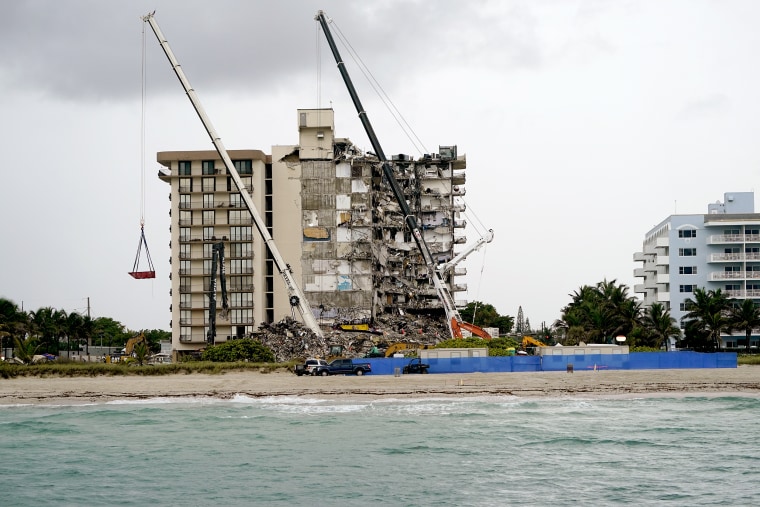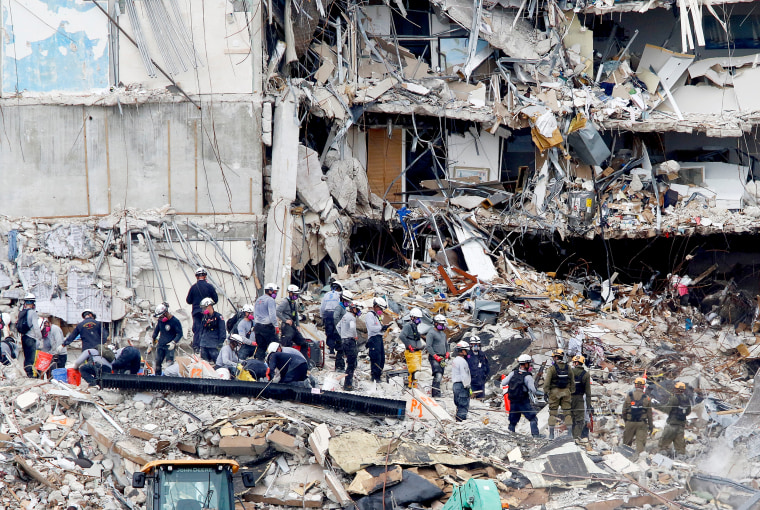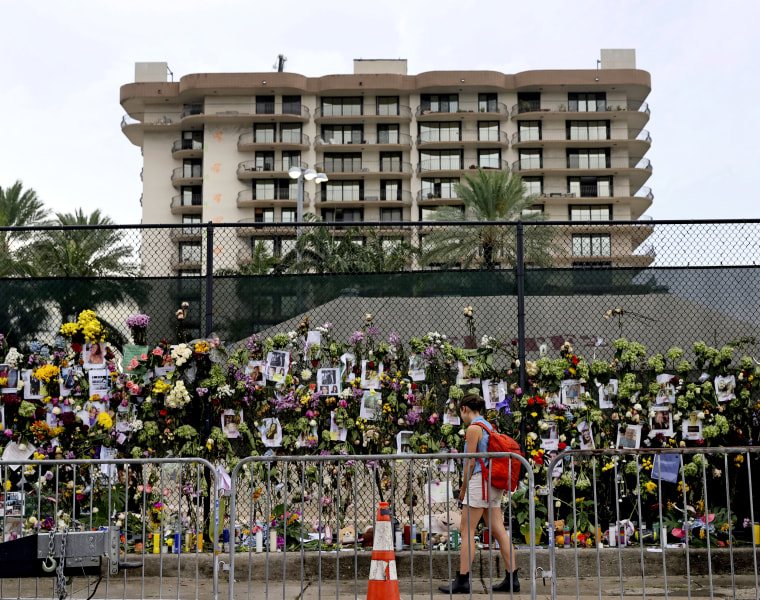Nearly half a century has passed since the collapse of a Drug Enforcement Agency office in Miami killed seven people and drove changes to local building codes. The new regulations required owners to check buildings that reached 40 years old for signs of deterioration in a wet, salty, storm-prone climate.
The rules have largely served South Florida well, ensuring that building owners make repairs before small problems turn catastrophic. And yet these rules did not prevent last week’s collapse of Champlain Towers South. While the cause of the collapse remains under investigation, officials and experts are calling for an examination of the rules, and whether they need to be updated, after the failure of the 12-story condominium building that stood at the edge of the Atlantic Ocean on a barrier island that includes Miami Beach.
The condo’s owners association had known for two-and-a-half years about a flaw in the original construction and major structural damage caused by water and salt infiltrating the concrete and eating away at the steel inside, a common problem in coastal buildings, documents show. But they failed to fix it.
Whether those repairs — delayed by leadership changes at the condo association, financial concerns and the burdens of managing a massive construction project — would have saved Champlain Towers South and the 148 people who were killed or are still missing is not known. The investigation of the collapse is still in its early stages. Residents told town officials in early 2019 they were worried about the destabilizing effects of a building under construction next door, though the developer of that building denied causing the collapse, and an environmental scientist has documented that Champlain Towers South had very gradually sunk in the 1990s — a potential sign of sea level rise. For now, authorities remain focused on the rescue mission.

But the 40-year checkup, called recertification, could play a key role in understanding why a portion of the 136-unit tower crumbled and who is to blame.
The process — documented in engineering reports, building records, permits, emails and condo board communications reviewed by NBC News — reveals the shortcomings of a system that relies on volunteer condo boards to balance the building’s books along with the demands of hired consultants, government inspectors and residents, experts and officials say. With search-and-rescue teams still digging through the rubble, and relatives of the missing clinging to hope, some have begun to ask whether the region’s building codes, already among the country’s toughest, need another update.
“The fact that two-and-a-half years went by and nothing had been started yet shows that things broke down,” said David Haber, a Miami lawyer who specializes in laws governing construction and condominiums. He believes building officials should require faster repairs from condo boards, which are often under pressure from residents to keep costs down and avoid disruptive projects. “We have to make it so there’s more urgency.”
Florida state Sen. Jason Pizzo, a Democrat whose district includes the town of Surfside, where the building collapsed, said inspections should take place after 20 years, not 40, for buildings like Champlain Towers South, built in 1981 during a coastal condo-building boom. He also thinks the recertification requirement, which is on the books only in Miami-Dade and Broward counties, should be adopted statewide.
“The recertification process is a very good thing, but it needs to be expanded and made more comprehensive,” Pizzo said.
Miami-Dade County, which includes Surfside, requires that all buildings with more than 10 occupants get recertified, a process that typically begins with the local building official sending a notice that the 40-year inspection is due. That sets the clock ticking: Within 90 days, the building’s owner must submit an engineer’s report certifying that the building is safe and outlining any needed repairs. The owner has another 60 days to make those repairs.
But building officials often allow that work to go on longer if they believe the owner is making a good-faith effort, said Edward Rojas, the building official for Miami-Dade County. If repairs go uncompleted for too long, though, officials can impose fines, and if the building is deemed unsafe, they can move to have it evacuated.
It appears that timeline didn’t apply to Champlain Towers South because it started its recertification process early, long before Surfside officials would have asked. The building turned 40 this year. But the Champlain Towers South Condominium Association took the first step in 2018, hiring a structural engineer to inspect the property.
The engineer, Frank Morabito, issued a report in October 2018, flagging “major structural damage” to concrete slabs underneath the building’s pool deck and entrance drive. He blamed a “major error” in the building’s construction that prevented water from properly draining and recommended a complete reconstruction of that section. He warned that the work would “create a major disturbance” for residents and “be extremely expensive.” His estimate for those repairs and others was $9 million, a bill that would have to be shouldered by the residents, through a special assessment on their units.
The condominium association invited the town building official to give his opinion. The official, Rosendo Prieto, said it appeared the building was “in very good shape,” according to minutes of the meeting. Prieto, in turn, emailed the town manager with his impressions. “The response was very positive from everyone in the room,” Prieto wrote. “All main concerns over their forty year recertification process were addressed.”
Prieto no longer works for Surfside and could not be reached for comment. He told the Miami Herald last week that he didn’t remember receiving Morabito’s report and did not recall any major concerns with the building. “If there had been, they would have been addressed right away,” he told the newspaper.
Prieto is now employed by C.A.P. Government Inc., which provides building department services for local governments. He was assigned to be a temporary building official in the city of Doral, Florida, but the company told the city on Monday that Prieto was on a leave of absence, the city said in a statement.

Residents would later say they were given the impression that the work was not dire. Susana Alvarez, who lived in Champlain Towers South, said that her takeaway from the 2018 meeting was that Surfside town officials said "that the building was not in bad shape."
Moshe Candiotti, who moved in 14 months ago, said he was never told about the damage. “Why didn’t they shut the building at the time?” Candiotti asked.
Rick Slider, a structural engineer who has worked on condo towers in the Surfside area, said Morabito’s assessment should have more strongly emphasized the high-priority nature of the damage so that people without technical expertise — like condo board members — would clearly understand the risk of waiting.
“The confusing part of Morabito’s report is it doesn’t sound urgent but mentions issues of having to replace the concrete slab that is in structural distress in its entirety,” he said. “As a structural guy, that raises the level up for me dramatically.”
Morabito did not immediately respond to a request for comment Wednesday. His company released a statement saying in part: “We are deeply troubled by this building collapse and are working closely with the investigating authorities to understand why the structure failed.”
A spokesman for the condo association board said its members were trying their best to keep residents safe. “They are not engineers and not building safety experts. They hired experts, trusted experts, and at no point did the experts indicate that there was a threat of imminent collapse,” the spokesman, Maxwell Marcucci, said.
Building officials often defer to the judgment of structural engineers in such situations, Slider said. But while Champlain Towers South was working ahead of the recertification schedule, it took a lot longer to start work than is typical, he said.
“In my experience, I have never seen anybody wait almost three years like they did,” Slider said.
A media relations liaison for the town of Surfside said he could not make anyone available to speak about the recertification process.
After receiving Morabito’s assessment, the Champlain Towers South board of directors went to other engineers for additional assessments of what the building needed and what it would cost. The board was slowed by frequent turnover, including a period of several weeks in mid-2019 when the majority of members resigned.
Eventually, the board agreed to hire Morabito to oversee the project. Morabito took a deeper look at the damage and found that it had worsened — and the price had risen. Morabito put the new bill at $16 million.
While the residents debated how to proceed, the board began a roof repair project early this year that was not part of the original plan. And it began taking bids for the reconstruction project, with the winner expected to be announced in July. Some residents asked for the project to be reduced in scope, saying the plan was not “fiscally prudent,” according to minutes from the April 13 meeting.

Board president Jean Wodnicki wrote residents a letter in early April saying the time had come to swallow the costs and get the repairs done. “A lot of this work could have been done or planned for in years gone by. But this is where we are now,” she wrote.
On April 13, the board voted to approve a plan to pay for the work over 15 years through a special assessment that would cost owners $80,000 to $336,000 each.
Morabito began inviting contractors who wanted to bid on the project to view the building. Those visits continued up until the day before the collapse.
Standing near the rubble on Monday, Robert Lisman, who lives in the nearby Champlain Towers East, built in 1994, told NBC News that his grief had turned to anger over the slow movement of the Champlain Towers South condo association.
“To me it’s pure negligence and incompetence at the highest level,” he said.
Surfside Town Manager Andrew Hyatt said on MSNBC this week that Champlain Towers South was only required to start the recertification process this year. He said he wanted to shorten the recertification period for buildings from 40 years to 20.
Koby Karp, a local architect, said last week’s collapse would serve as a “watershed point” that will lead to a new “look at how we inspect these buildings.”
But John Pistorino isn’t so sure. He was an engineering consultant for Miami-Dade County when the Drug Enforcement Agency building collapsed in 1974, and helped develop the recertification standard of 40 years. The regulation is designed to catch issues that emerge in aging buildings, he said, but it is not meant to be used to avoid more frequent repairs.
“It’s been working fairly well over all these years,” said Pistorino, who now runs an engineering firm that bids on condo projects. “The 40 years is not the issue. The issue is that the owners have a responsibility to maintain buildings according to code all along.”
